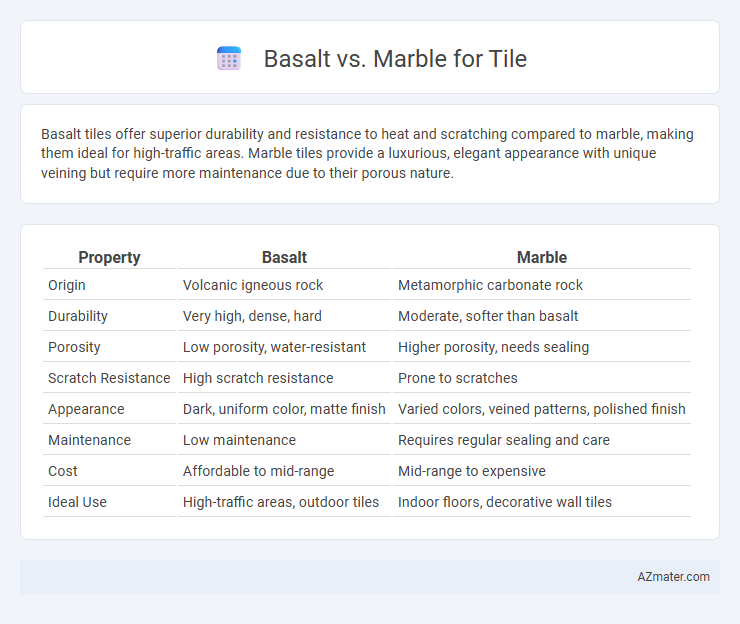Basalt tiles offer superior durability and resistance to heat and scratching compared to marble, making them ideal for high-traffic areas. Marble tiles provide a luxurious, elegant appearance with unique veining but require more maintenance due to their porous nature.
Table of Comparison
| Property | Basalt | Marble |
|---|---|---|
| Origin | Volcanic igneous rock | Metamorphic carbonate rock |
| Durability | Very high, dense, hard | Moderate, softer than basalt |
| Porosity | Low porosity, water-resistant | Higher porosity, needs sealing |
| Scratch Resistance | High scratch resistance | Prone to scratches |
| Appearance | Dark, uniform color, matte finish | Varied colors, veined patterns, polished finish |
| Maintenance | Low maintenance | Requires regular sealing and care |
| Cost | Affordable to mid-range | Mid-range to expensive |
| Ideal Use | High-traffic areas, outdoor tiles | Indoor floors, decorative wall tiles |
Overview of Basalt and Marble Tiles
Basalt tiles, formed from rapidly cooled volcanic lava, exhibit a dense, fine-grained texture that is highly durable and resistant to wear, making them ideal for both indoor and outdoor applications. Marble tiles, composed of metamorphosed limestone, are renowned for their elegant veining and polished surface, providing a luxurious aesthetic but with lower scratch resistance and higher porosity compared to basalt. Both materials offer unique visual and physical properties, with basalt favored for strength and slip resistance, while marble is prized for its classic beauty and smooth finish.
Geological Origins: Basalt vs Marble
Basalt is an extrusive igneous rock formed from the rapid cooling of basaltic lava at the Earth's surface, characterized by its fine-grained texture and dark color. Marble is a metamorphic rock created when limestone undergoes intense heat and pressure, resulting in recrystallized calcite with a distinctive veined appearance and lighter color palette. The volcanic origins of basalt contribute to its durability and density, while marble's sedimentary roots and metamorphic transformation yield a comparatively softer, more porous tile option.
Physical Properties Comparison
Basalt exhibits higher density and hardness, making it more resistant to scratches and wear compared to marble, which is softer and more porous. Marble's calcium carbonate composition results in greater susceptibility to etching and staining, while basalt's volcanic origin provides superior durability and resistance to chemical damage. Both stones offer unique aesthetic appeal, but basalt's physical properties ensure enhanced longevity and maintenance ease in high-traffic tile applications.
Durability and Longevity
Basalt tiles exhibit exceptional durability due to their dense, fine-grained volcanic rock composition, making them highly resistant to scratches, chips, and weathering. Marble tiles, while elegant and timeless, are softer and more porous, which makes them prone to etching and staining, requiring more maintenance to preserve their appearance over time. For long-term durability, basalt is often preferred in high-traffic or outdoor areas, whereas marble is better suited for low-traffic, interior applications.
Aesthetic Appeal and Design Versatility
Basalt offers a sleek, matte finish with deep, uniform tones that enhance modern and minimalist design aesthetics, while marble features classic veining and a polished surface that exudes timeless elegance and luxury. Marble tiles provide versatile patterns and color variations that suit both traditional and contemporary interiors, whereas basalt's consistent texture supports bold, monochromatic schemes. The choice between basalt and marble significantly impacts the visual ambiance, with marble elevating sophistication and basalt promoting understated, natural beauty.
Installation Process and Requirements
Basalt tiles require professional installation due to their density and hardness, necessitating diamond-tipped blades and high-quality adhesives to ensure proper adhesion and longevity. Marble tiles, being softer and more porous, demand careful handling, a moisture-resistant substrate, and specialized grout to prevent staining and damage during installation. Both materials benefit from a level substrate and sealing post-installation, but basalt's durability often results in a more labor-intensive process compared to marble.
Maintenance and Cleaning Differences
Basalt tiles require less frequent sealing and are more resistant to staining compared to marble, making maintenance simpler. Marble tiles need regular sealing and careful cleaning with pH-neutral products to avoid etching and dulling from acidic substances. Both materials benefit from prompt spill cleanup, but basalt's durability offers a lower-maintenance option for high-traffic areas.
Cost Analysis: Basalt vs Marble Tiles
Basalt tiles generally cost less than marble tiles, making them a more budget-friendly option for flooring and wall applications. While marble prices fluctuate depending on the quality and origin, basalt offers consistent pricing due to its abundant availability and durability. Installation costs for basalt are also typically lower because of its uniform hardness and easier cutting properties compared to marble.
Environmental Impact and Sustainability
Basalt tiles have a lower environmental impact than marble due to their abundant natural availability and lower energy-intensive extraction processes. Marble quarrying often results in significant habitat disruption and higher carbon emissions from extensive cutting and transportation. Basalt's durability and low maintenance contribute to longer lifecycle sustainability, reducing the need for frequent replacements compared to marble tiles.
Choosing the Right Tile for Your Project
Basalt offers exceptional durability and a dense, fine-grained texture ideal for high-traffic areas, while marble provides a classic, elegant appearance with unique veining suitable for decorative spaces. Consider the project's location, wear resistance requirements, and style preference when choosing between basalt's superior hardness and marble's luxurious aesthetic. For outdoor or heavy-use installations, basalt's non-porous nature reduces staining and weathering, whereas marble requires regular sealing and maintenance to preserve its polished look.

Infographic: Basalt vs Marble for Tile
 azmater.com
azmater.com